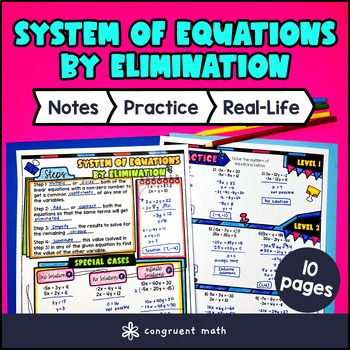Want more ideas and freebies?
Get my free resource library with digital & print activities—plus tips over email.
Join for Free Resources →
$4.25
Ever wondered how to teach system of linear equations by elimination in an engaging way to your 8th-grade students?
In this lesson plan, students will learn about solving system of equations by elimination and their real-life applications. Through artistic, interactive guided notes, check for understanding, practice coloring worksheet, and a maze worksheet, students will gain a comprehensive understanding of solving simultaneous linear equations by elimination.
The lesson ends with a real-life example that explores how system of equations by elimination can be applied in practical scenarios.

$4.25
After this lesson, students will be able to:
Before this lesson, students should be familiar with:
As a hook, ask students why knowing how to solve a system of linear equations by elimination might be important in real life situations. Refer to the last page of the guided notes as well as the FAQs below for ideas.
Use the first page of the guided notes to introduce the concept of solving a system of linear equations by elimination. Walk through the process of obtaining a common coefficient to eliminate one variable so that you can solve for the other. Emphasize the importance of multiplying or divide the equations by a common factor so eliminate one variable first. Walk through the 4 examples on the first page of the guided notes with your students. This will allow them to see the cases where the system contains one solution, no solution, or infinite solutions.
Continue with the second page of the guided notes to have students practice how to apply the elimination method to solve pairs of simultaneous linear equations. The practice is divided into 3 levels of difficulty. Students will encounter problems where the system of linear equations has one solution, no solution, or infinite solutions.
Throughout the guided notes, monitor student understanding and engagement. Based on student responses during the introduction, reteach any concepts that students may need extra help with. If there is a wide range of proficiency levels in your class, consider pulling out students for additional reteaching while more advanced students can begin working on the practice exercises.
Have students practice solving system of equations by elimination using the practice worksheet (pg. 2 of guided notes) provided in the resource. Then, have them move onto the maze activity (pg. 3 of guided notes). Walk around to answer student questions.
Fast finishers can dive into the color by number activity (pg. 4 of guided notes) for extra practice. You can assign it as homework for the remainder of the class.
Using the last page of the guided notes (pg. 5), bring the class back together, and introduce the concept of using simultaneous linear equations by elimination to solve real-world problems, such as calculating costs for a combination of items, determining the number of different types of items to produce to meet a specific budget, or analyzing scenarios where two variables are interdependent. Refer to the FAQ for more ideas on how to teach it!
If you’re looking for digital practice for adding and subtracting numbers in scientific notation, try my Pixel Art activities in Google Sheets. Every answer is automatically checked, and correct answers unlock parts of a mystery picture. It’s incredibly fun, and a powerful tool for differentiation.
Here are some activities to explore:
A fun, no-prep way to practice adding and subtracting numbers in scientific notation is Doodle Math — they’re a fresh take on color by number or color by code. It includes multiple levels levels of practice, perfect for a review day or sub plan.
Here are some activities to try:
Solving a system of equations by elimination involves adding or subtracting the equations to eliminate one of the variables, making it easier to solve for the remaining variable.
Key Points:
Solving systems of equations by elimination is useful when the coefficients of one of the variables are opposites, allowing for easy elimination to find the solution.
Key Points:
The step-by-step process of solving a system of equations by elimination involves identifying the variables to eliminate, adding or subtracting the equations to remove a variable, and solving for the remaining variable.
Key Points:
Solving systems of equations by elimination is used in real-life scenarios such as calculating costs with different pricing structures or determining solutions that satisfy multiple conditions simultaneously.
Key Points:
Using guided notes and doodles to teach system of equations by elimination helps engage students visually, reinforces key concepts through visual representations, and provides a structured format for learning.
Key Points:
Effective strategies for teaching system of equations by elimination to 8th-grade students include breaking down the process into manageable steps, providing real-life examples, encouraging peer collaboration, and offering visual aids for better understanding.
Key Points:
Get my free resource library with digital & print activities—plus tips over email.
Join for Free Resources →